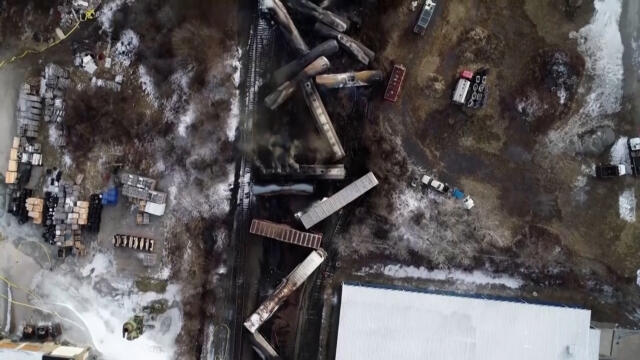Months-Long Persistence Of Toxic Chemicals After Ohio Train Derailment

Table of Contents
The Nature and Persistence of Released Chemicals
The Ohio train derailment released a cocktail of toxic chemicals, including vinyl chloride, butyl acrylate, and ethylhexyl acrylate. These chemicals pose significant health risks, with vinyl chloride, for example, being a known carcinogen linked to liver cancer and other serious illnesses. Butyl acrylate and ethylhexyl acrylate are also irritants and can cause respiratory problems, skin irritation, and eye damage.
- Chemical Persistence: The persistence of these chemicals is a major concern. Many of these substances have low water solubility, meaning they don't readily dissolve and wash away. This contributes to their persistence in soil and their potential to contaminate groundwater sources for extended periods.
- Chemical Half-Life: The concept of chemical half-life is crucial here. The half-life refers to the time it takes for half of a substance to break down. Many of the chemicals released have relatively long half-lives, meaning they can remain in the environment for months, even years, posing a continued threat.
- Bioaccumulation: Another significant worry is bioaccumulation. This is the process by which chemicals accumulate in the tissues of living organisms. If these chemicals enter the food chain – through contaminated water or soil – they can build up in animals, potentially reaching dangerous levels for consumers further up the chain, including humans.
Contamination of Water and Soil Resources
The extent of water and soil contamination resulting from the Ohio train derailment is alarming. Initial reports revealed significant contamination of local waterways, including the Ohio River, with several toxic chemicals detected above safe levels.
- Water Pollution: Surface water contamination poses an immediate threat to aquatic life and drinking water supplies. The long-term effects on aquatic ecosystems remain uncertain, requiring extensive ongoing monitoring. Groundwater contamination is a particularly insidious problem, as it can persist for decades and contaminate drinking water wells.
- Soil Pollution: Soil testing in the affected area reveals significant contamination with various toxic chemicals. The persistence of these chemicals in soil makes agricultural use of the land problematic and creates a pathway for contamination through the food chain. Remediation of contaminated soil is a lengthy and costly process.
- Remediation Efforts: While cleanup efforts are underway, their adequacy and effectiveness remain a subject of debate and concern. The challenges of effective remediation are considerable, given the widespread contamination and the complex nature of the released chemicals. Ongoing monitoring of water and soil quality is critical to assess the effectiveness of cleanup efforts.
Health Risks and Community Impact
The health risks associated with exposure to the released chemicals are substantial, ranging from immediate respiratory irritation to long-term health problems.
- Public Health Concerns: Residents of East Palestine have reported a range of health issues, including respiratory problems, headaches, skin rashes, and gastrointestinal problems. These reported issues highlight the urgent need for comprehensive health monitoring and support for the affected population.
- Long-Term Health Effects: The long-term health effects of exposure to these chemicals remain unknown but are cause for significant concern. The potential for increased cancer risk, reproductive problems, and neurological damage warrants intensive investigation and long-term health surveillance.
- Mental Health Impact: Beyond the physical health risks, the derailment has caused significant psychological distress within the East Palestine community. Fear, uncertainty, and displacement have taken a toll on mental health, underscoring the need for psychosocial support services.
The Inadequate Cleanup Efforts and Government Response
Concerns remain regarding the adequacy of the cleanup efforts and the government's response to the disaster.
- EPA Investigation and Oversight: While the Environmental Protection Agency (EPA) is involved, questions remain about the thoroughness of the investigation, the effectiveness of remediation strategies, and the transparency of the process. The community is demanding increased transparency and accountability in all aspects of the response.
- Community Concerns: The community's concerns extend beyond environmental remediation to encompass long-term health monitoring, economic support, and fair compensation for losses. Addressing these concerns is critical for restoring trust and rebuilding the community.
Conclusion
The months following the Ohio train derailment have revealed the alarming persistence of toxic chemicals in the environment and the potential for long-term health and ecological consequences. The inadequate cleanup efforts and ongoing community concerns highlight the urgent need for comprehensive investigation, transparent communication, and effective remediation strategies. The long-term implications of this disaster demand continued vigilance and robust action.
Call to Action: Understanding the months-long persistence of toxic chemicals after the Ohio train derailment is crucial for ensuring the long-term health and well-being of the affected community and environment. We must demand accountability, increased transparency, and robust, ongoing monitoring of the situation. Demand better from your representatives regarding the long-term effects of the Ohio train derailment and support efforts for comprehensive environmental remediation. The persistence of these toxins demands continued attention and action.

Featured Posts
-
 Abba Voyage Setlist Changes And Band Statement
May 19, 2025
Abba Voyage Setlist Changes And Band Statement
May 19, 2025 -
 Tony Todds Final Role In Final Destination Bloodline Trailer A Bittersweet Farewell
May 19, 2025
Tony Todds Final Role In Final Destination Bloodline Trailer A Bittersweet Farewell
May 19, 2025 -
 Investigation Into Puri You Tubers Jai Hind Post Connection To Pakistani Spy Jyoti Malhotra On Instagram
May 19, 2025
Investigation Into Puri You Tubers Jai Hind Post Connection To Pakistani Spy Jyoti Malhotra On Instagram
May 19, 2025 -
 Jyoti Malhotra You Tubers Pahalgam Trip Before Terror Attack Raises Concerns Of Pakistan Links
May 19, 2025
Jyoti Malhotra You Tubers Pahalgam Trip Before Terror Attack Raises Concerns Of Pakistan Links
May 19, 2025 -
 Istoria Kai Simasia Ton Onomastirion Toy Ierosolymon T Heofiloy
May 19, 2025
Istoria Kai Simasia Ton Onomastirion Toy Ierosolymon T Heofiloy
May 19, 2025
